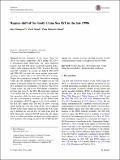| dc.contributor.author | Thompson, Bijoy | |
| dc.contributor.author | Tkalich, Pavel | |
| dc.contributor.author | Rizzoli, Paola M | |
| dc.date.accessioned | 2017-03-10T19:01:26Z | |
| dc.date.available | 2017-03-10T19:01:26Z | |
| dc.date.issued | 2016-05 | |
| dc.date.submitted | 2016-03 | |
| dc.identifier.issn | 0930-7575 | |
| dc.identifier.issn | 1432-0894 | |
| dc.identifier.uri | http://hdl.handle.net/1721.1/107387 | |
| dc.description.abstract | Decadal variability of the South China Sea (SCS) sea surface temperature (SST) during 1982–2014 is investigated using observations and ocean reanalysis datasets. The SCS SST shows an abrupt transition from a cold-to-warm regime in the late 1990s. Based on the long-term SST variability two epochs are defined, 1982–1996 and 2000–2014 as cold and warm regimes respectively, spanning on either side of the 1997–1999 SCS warming. Despite the occurrence of strong El Nino induced warming events, the SST anomalies tend to be negative in the cold regime. Conversely during the warm regime, the positive SST anomalies have dominated over the La Nina driven cooling events. The cold (warm) SST regime is marked by net heat gain (loss) by the SCS. The long-term variations of net surface heat flux are mainly driven by the latent heat flux anomalies while the short wave flux plays a secondary role. Low-frequency variability of the South China Sea throughflow (SCSTF) appears to be closely related to the SCS SST regime shift. The SCSTF shows reversing trends during the cold and warm epochs. The weakened SCSTF in the warm regime has promoted the SCS warming by limiting the outward flow of warm water from the SCS. Meanwhile, enhanced SCSTF during the cold regime acts as a cooling mechanism and lead to persistent negative SST anomalies. The change in trend of the SCSTF and SST regime shift coincides with the switching of pacific decadal oscillation from a warm to cold phase in the late 1990s. | en_US |
| dc.description.sponsorship | Singapore. National Research Foundation (Singapore MIT Alliance for Research and Technology’s Centre for Environmental Sensing and Modeling interdisciplinary research program) | en_US |
| dc.publisher | Springer Berlin Heidelberg | en_US |
| dc.relation.isversionof | http://dx.doi.org/10.1007/s00382-016-3178-4 | en_US |
| dc.rights | Creative Commons Attribution-Noncommercial-Share Alike | en_US |
| dc.rights.uri | http://creativecommons.org/licenses/by-nc-sa/4.0/ | en_US |
| dc.source | Springer Berlin Heidelberg | en_US |
| dc.title | Regime shift of the South China Sea SST in the late 1990s | en_US |
| dc.type | Article | en_US |
| dc.identifier.citation | Thompson, Bijoy, Pavel Tkalich, and Paola Malanotte-Rizzoli. “Regime Shift of the South China Sea SST in the Late 1990s.” Climate Dynamics (May 20, 2016). | en_US |
| dc.contributor.department | Massachusetts Institute of Technology. Department of Earth, Atmospheric, and Planetary Sciences | en_US |
| dc.contributor.mitauthor | Rizzoli, Paola M | |
| dc.relation.journal | Climate Dynamics | en_US |
| dc.eprint.version | Author's final manuscript | en_US |
| dc.type.uri | http://purl.org/eprint/type/JournalArticle | en_US |
| eprint.status | http://purl.org/eprint/status/PeerReviewed | en_US |
| dc.date.updated | 2017-02-02T15:20:22Z | |
| dc.language.rfc3066 | en | |
| dc.rights.holder | Springer-Verlag Berlin Heidelberg | |
| dspace.orderedauthors | Thompson, Bijoy; Tkalich, Pavel; Malanotte-Rizzoli, Paola | en_US |
| dspace.embargo.terms | N | en |
| dc.identifier.orcid | https://orcid.org/0000-0003-2431-6838 | |
| mit.license | OPEN_ACCESS_POLICY | en_US |
| mit.metadata.status | Complete | |

